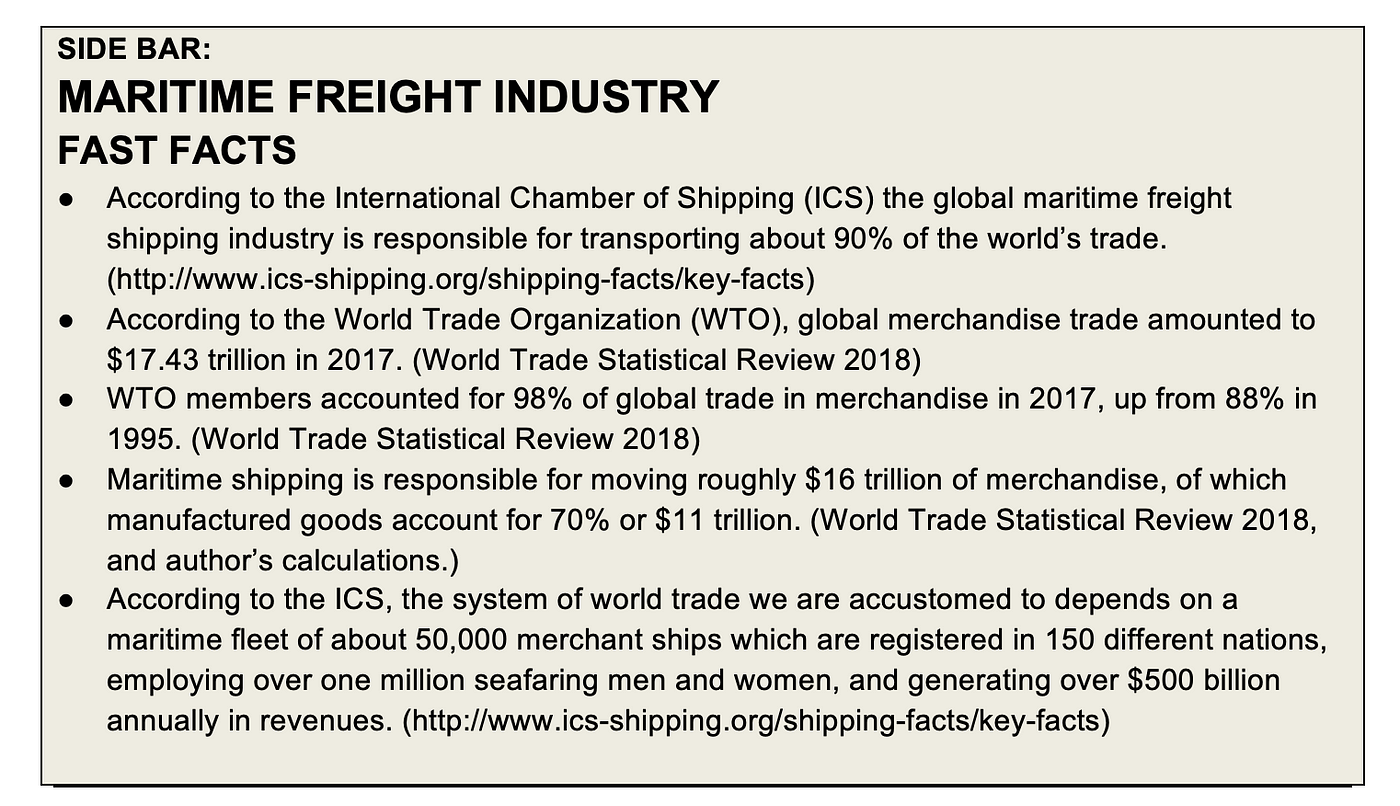Note: A version of this story was first published on April 30, 2019, at FreightWaves.
The maritime freight shipping industry is central to the functioning of the modern world. Yet it is foreign to most people because it is largely hidden from view. A big change in the way the industry uses oil will come into effect on January 1, 2020. This change is an indication of even more changes to come. These changes will affect everyone, and everything. However, the coming change also presents a great opportunity.
Here are some facts about the maritime freight shipping industry:
- According to the World Shipping Council (WSC) the global maritime freight shipping industry is responsible for transporting about 90% of the world’s trade.
- According to the World Trade Organization (WTO), global merchandise trade amounted to $17.43 trillion in 2017.
- WTO members accounted for 98% of global trade in merchandise in 2017, up from 88% in 1995.
- So the maritime shipping industry is responsible for moving roughly $16 trillion of merchandise, of which manufactured goods account for 70% or $11 trillion.
- According to the WSC, the system of world trade the world has become accustomed to depends on a maritime fleet of about 50,000 merchant ships which are registered in 150 different nations, employing over one million seafaring men and women, and generating over $500 billion annually in revenues.
Why should you care? The shipping industry has played a central role in globalization. It provides an incredibly efficient mode of transporting merchandise manufactured in relatively low-wage countries to customers in relatively high-wage countries. It also facilitates a highly cost-effective trade in non-manufactured goods. For example, Wiskerke Onions reportedly exports about 185,000 metric tons (more than 400 million pounds) of onions, shallots and garlic and exports about 90% of its products to 125 countries around the world. This is made possible by containerized shipping.
Shipping is a capital intensive industry. Despite its size and significance, shipping as a business is characterized by low profit margins and frequent boom and bust cycles.
The International Maritime Organization (IMO) “is the United Nations specialized agency with responsibility for the safety and security of shipping and the prevention of marine and atmospheric pollution by ships.” It has 174 Member States and 3 Associate Members. On January 1, 2020 the IMO will begin implementing a 0.5% cap on the sulphur content of marine fuel, replacing the existing cap of 3.5%. This change is in addition to a 0.1% cap on sulphur content that is imposed on ships in emission control areas (ECAs).
Why is the IMO introducing the new sulphur cap? This measure is the culmination of concerns among the IMO’s members about the impact that the international shipping industry has on atmospheric pollution, global warming, and climate change. The industry’s emissions lead to about 400,000 premature deaths from lung cancer and cardiovascular disease, and about 14 million childhood asthma cases annually (Jalkanan, Corbett et al., 2018).
This measure does not address nitrogen oxides, carbon dioxide, and particulate matter — each of which is present in emissions resulting from shipping, and so the sulphur cap is the first of a number of regulations that will need to be implemented if the IMO’s member states remain committed to minimizing the industry’s negative impact on climate change.
The data below from NASA’s Global Climate Change portal puts things in context.
The first graph shows NASA’s Global Land-Ocean Temperature Index, which measures the change in global surface temperature relative to 1951–1980 average temperatures. The index has been on an increasing trend since 1910 when it attained its lowest value, meaning that the warmest years on record have been the most recent.
The second graph shows atmospheric carbon dioxide (CO2) levels measured at Mauna Loa Observatory, Hawaii, in recent years, with average seasonal cycle removed. Measuring atmospheric CO2 is important because it traps heat generated by human activity and natural processes in the earth’s atmosphere.
The third graph shows changes in sea level since 1993. Sea level changes due to melting ice sheets and expanding seawater as the world’s oceans and seas become warmer.
The new rules, and others that professional observers of the shipping industry expect the IMO will introduce in the future, will have the effect of making the business of transporting the world’s merchandise more expensive. According to a 2017 Wood Mackenzie Study, global marine fuel costs could increase by up to $60 billion annually in a full compliance scenario. Shipping companies will also be confronted by new capital expenditures for equipment to retrofit existing fleets and an increase in ongoing operating costs. The most certain outcome of these developments is that ocean freight rates will increase, and eventually these increases will be passed-through to the individual consumer. In other words, we should expect price increases for 90% of the things we consume.
There’s intense discussion within the industry about the future. For example, Maersk, the world’s largest container shipping line, has stated that it is taking steps to become carbon neutral by 2050. This discussion takes on increased urgency as the stark realities of global warming and climate change become more pronounced. The traditional solutions to the challenge of greatly reducing emissions from the shipping industry are interesting and we should keep pursuing them. However, I am most excited about the opportunity this presents to consider radically new approaches to solving the problem; New materials for ship construction, new methods of powering ships, 3D printing and localized manufacturing, automation and optimization, and better use of data for predictive analytics, among others.
The business of moving the world’s freight across the oceans and seas is an awesome and critical responsibility. Difficult problems are gathering on the horizon. Difficult problems always offer an opportunity to think different, to think boldly, to refashion existing systems, and to champion the innovators among us who we may have ignored in the past.

